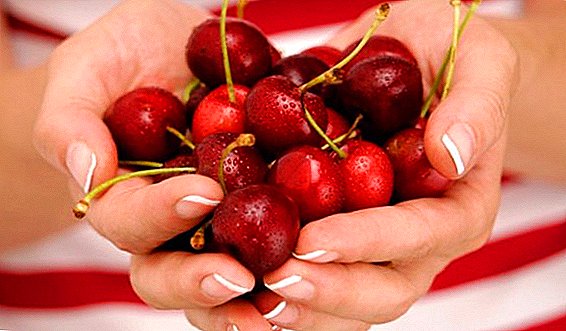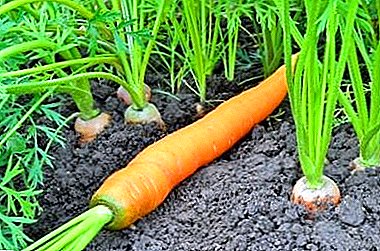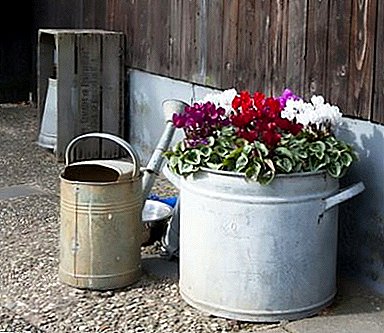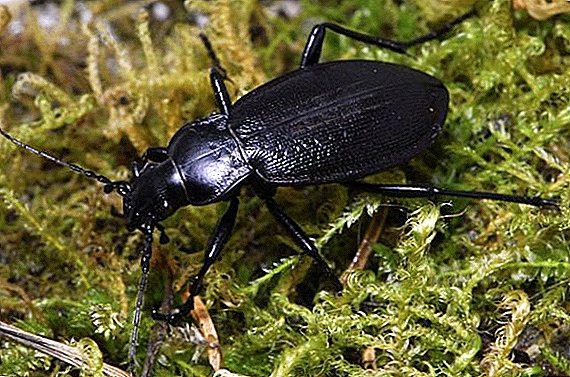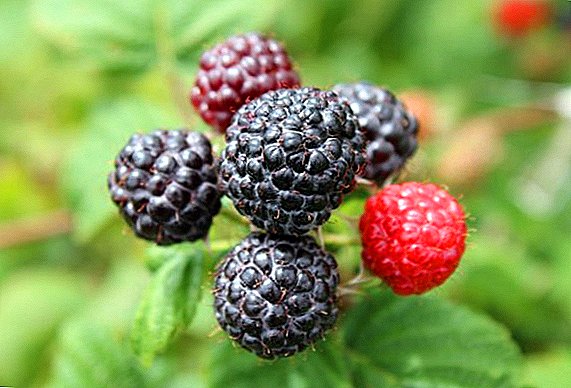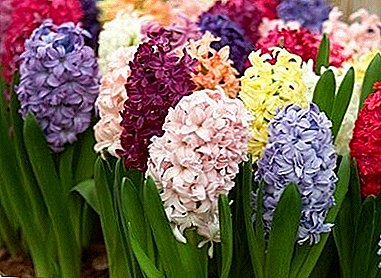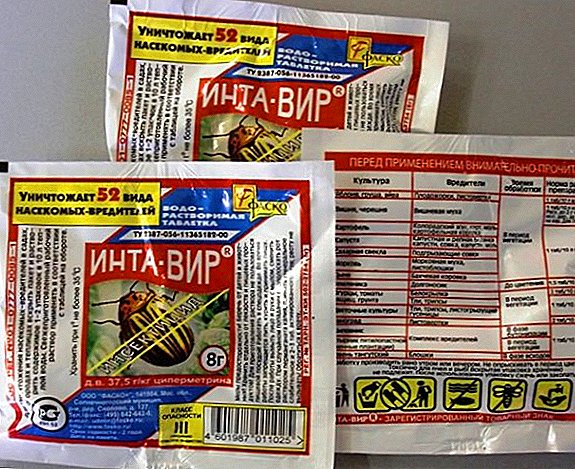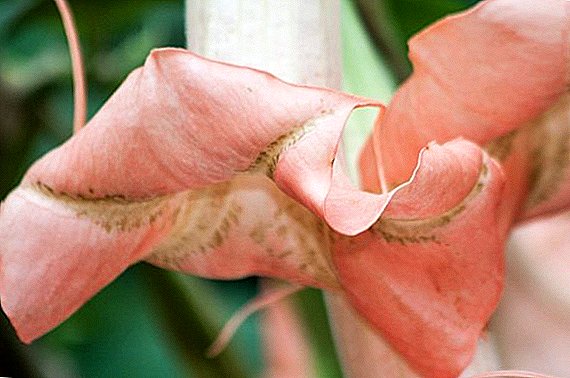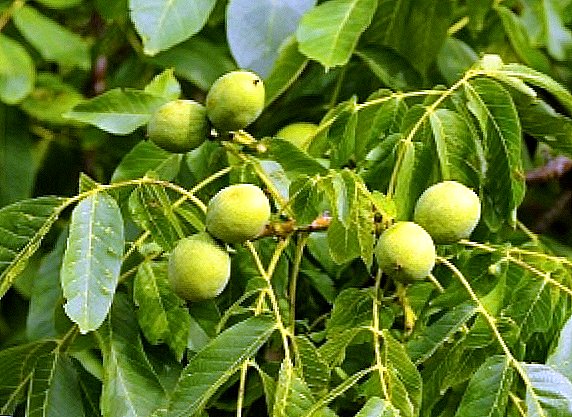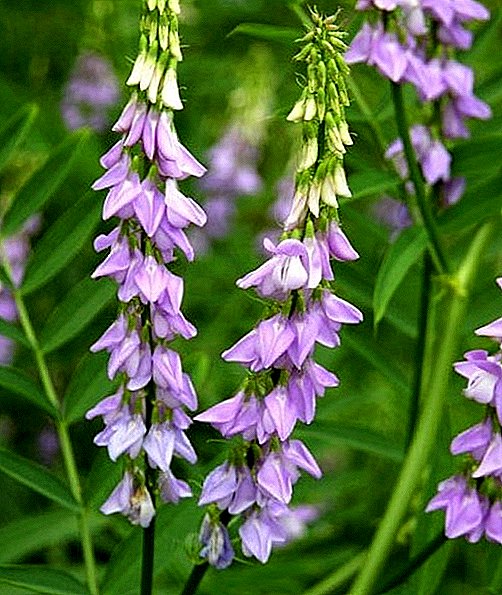 Root licorice known to most of us since childhood as a remedy for cough. But few know that this is far from the only quality by which licorice (another name for licorice) has been widely used in various branches of human life. Let's learn more about this useful plant.
Root licorice known to most of us since childhood as a remedy for cough. But few know that this is far from the only quality by which licorice (another name for licorice) has been widely used in various branches of human life. Let's learn more about this useful plant.
Botanical description
Licorice - perennial herb from the family of legumes. Widely distributed almost worldwide. On the territory of the former Soviet Union grows 7 types of licorice. The most common - licorice.
The plant reaches a height of 1 m and more. There are several stems - they carry round, leaves growing in pairs and small light-violet flowers collected in a brush. From the head, thick and branched rhizomes, horizontal shoots diverge from which new plants develop.  The result is a complex root system that is branched in horizontal and vertical directions. In depth it can reach 8 meters. That is, from one mother plant a whole plant system is formed, branched out over a large area like a mycelium.
The result is a complex root system that is branched in horizontal and vertical directions. In depth it can reach 8 meters. That is, from one mother plant a whole plant system is formed, branched out over a large area like a mycelium.
Did you know? Glycyrrhizin contained in liquorice is 50 times sweeter than sugar.
The fruit of the plant is a bob up to 3 cm long, in which there can be up to 8 seeds. They are gray and shiny, with a diameter of about 5 mm.
Chemical composition
Licorice contains many nutrients:
- glycyrrhizin (7%);
- glycyrrhizic acid (23%);
- potassium and calcium salts of glycyrrhizic acid;
- flavone glycosides (likvritin, likvitrilitigenin and likvritozid) - 4.5%;
- starch (23%);
- vitamin C;
- pigments;
- pectin (4.5%);
- essential oil.

Medicinal properties
In medicine, the main use has received licorice root, due to its mucolytic action - the ability to thin the sputum and remove it from the body. Glycyrrhizin makes active pulmonary ciliated epithelium and increases the secretion of the mucous membrane of the upper respiratory tract.
Substances contained in the root of the plant (in particular, liquiditrioside), relieve spasm of smooth muscles.
Another property of licorice - anti-inflammatory effect, which is due to the presence in the composition of glycyrrhizic acid. This acid is involved in metabolic processes of the body, providing a corticosteroid effect. This pharmacological quality of licorice is the most valuable.
Did you know? Licorice is one of the fifty basic herbs of traditional Chinese medicine.
Application
The unique properties of the plant have been used not only in pharmaceuticals and medicine. Licorice is used in industry.
In medicine
The most famous use of licorice root is in the form of cough syrup. With a dry cough, the syrup liquefies the mucous membrane and clears the airways. In the wet - licorice flavonoids have their antispasmodic effect. It is safe to say that liquorice syrup has a universal effect.
Recently, methods of cleansing the lymphatic system of our body have become widespread. Many such techniques are based on the action of sorbents and licorice extract. Licorice in this case has a diluting effect, forcing the lymph to circulate faster through the body.  Accordingly, toxins and other harmful substances that have accumulated in it are rapidly eliminated from the body.
Accordingly, toxins and other harmful substances that have accumulated in it are rapidly eliminated from the body.
The above properties of liquorice root have also been used in diets. Licorice extract contributes to the normalization of gastrointestinal function.
Treatment of the gastrointestinal tract with herbs and other folk methods is a rather effective measure. For the treatment of gastrointestinal diseases are used: chaga, propolis tincture, sea buckthorn, flax, blueberry leaves, anise tincture.
After removing toxins and other harmful substances from organisms, the stomach and intestines begin to work better. The normalization of this function and the corresponding proper nutrition lead to a noticeable weight loss.
In cooking
Used as a sugar substitute for diabetics. In this case, licorice is a very economical variant of the sweetener. To create a sweet taste, you need a very small amount of root. Extract prevents mold processes, protects canned food from spoilage. Due to the foaming property, it is used in the production of kvass and beer. 
In industry
The foaming properties of licorice extract has only recently been used to make soap and fire extinguishers. Recently, cheaper synthetic components have been widely used.
Did you know? The ancient Greeks bought licorice root for gold from Scythians, they called it so: "Scythian root". A bunch of the roots of this plant was found in the tomb of Tutankhamen.
It is used in paint and varnish, textile industry, in leather production, in chemical and metallurgical industries. Liquorice extract production waste is a raw material for fertilizer production and sound insulation.
Contraindications
There are certain contraindications for use:
- Individual intolerance to the components and allergic reactions.
- The active substances of the plant contribute to the removal of potassium and sodium retention. A high content of sodium in the body leads to an increase in blood pressure. Do not use drugs licorice-based people with hypertension, as well as those who take drugs that reduce blood pressure.
- The low content of potassium in the body, caused by the use of preparations containing extract, contributes to degenerative changes in muscle tissue. Do not combine diuretic with licorice preparations.
- May affect the functioning of the heart. Patients with arrhythmia should not take drugs on the basis of licorice.
- Pregnancy and lactation.
- Children under 12 years old.
 It should be borne in mind that glycyrrhizin in the composition of licorice reduces the level of testosterone in men.
It should be borne in mind that glycyrrhizin in the composition of licorice reduces the level of testosterone in men.Important! Licorice can not be taken in conjunction with Beijing Euphorbia and Daphne.
Drugs from licorice: how to take
There are various ways to use licorice root. The most famous of all, perhaps, syrup. In addition to the syrup, at home you can make a decoction, tincture and alcohol tincture. How to do it right, and what drug from what helps, we describe below.
Decoction
For the decoction you need:
- crushed licorice root - 1 tbsp. spoon;
- boiling water - 0.25 ml.
Pour root water, hold for 20 minutes in a water bath. Then remove, allow to cool, filter and add water to the original volume. Take inside. Helps against hemorrhoids and as a mild laxative.
Infusion
For this infusion will need:
- ground root - 2 tsp;
- boiling water - 0.5 l.
You just need to fill the root with boiling water. After 8 hours the infusion is ready.
Infusion is used for problems of the gastrointestinal tract, colitis, constipation, liver disease and biliary tract. With diabetes and food poisoning. There is an opinion about the effectiveness of the tool when irradiated with a small dose of radiation.  Take it should:
Take it should:
- for children - a teaspoon three times a day;
- for adults - A tablespoon 4 times a day.
Did you know? In Uzbekistan, licorice is grown by an industrial method.
Syrup
To prepare the syrup at home you need to take:
- licorice extract - 5 g;
- sugar - 80 g;
- ethyl alcohol 70% - 10 ml.
All components are mixed and let stand for a day. Licorice syrup is still one of the most effective remedies for various types of cough (both dry and wet). Take the drug:
- for children - 1 tsp. 3-4 times a day;
- for adults - 1 tsp 4-5 times a day.

Tincture
You can make alcoholic liquorice root tincture at home:
- crushed licorice root - 10 g;
- alcohol 70% - 50 ml.
In a glass (preferably dark) dishes pour the chopped root, pour alcohol. Put in a dark place for three weeks. After this period, strain - and the tincture is ready.
They take 30 drops twice a day for coughing, problems with the gastrointestinal tract, lung diseases and even tuberculosis. In the form of lotions is used to treat dermatitis, eczema and other skin problems.
Licorice cultivation
The main difficulty in growing licorice on the plot is planting material. In our latitudes, the plant practically does not give seeds. Even if you manage to find and grow licorice seeds, you will get a normal root no earlier than after 6 years.
Sowing and reproduction
If you still find the seeds, the planting procedure should begin with soaking them with boiling water. This provokes the germination of seeds (they are covered with a hard shell, which prevents their germination, but reliably protects during the drought in semi-desert conditions - in the homeland of the plant). Seeds pour boiling water and leave to cool.  Sow the seeds should be in the greenhouse. Desired temperature is 19-21 ° C. Shoots appear in 10-15 days. After the appearance of the first four leaves, the plant can be transplanted to a permanent place.
Sow the seeds should be in the greenhouse. Desired temperature is 19-21 ° C. Shoots appear in 10-15 days. After the appearance of the first four leaves, the plant can be transplanted to a permanent place.
Important! The place for cultivation should have a constant access of sunlight. Even a slight shadow plant badly tolerates.
Be prepared for lots of weeds. They must be carefully removed.
In the first year of life in the autumn, it is necessary to dig between the beds and make manure (4 kg per sq. M) or nitrophoska (45 g per sq. M). Next spring ammophos fertilizers are applied to the soil (35 g per sq. M). After the first year of life, the plant usually reaches a height of 15-20 cm.
For wintering, do not remove dry stems. They will contribute to the delay of snow in winter, which will favorably affect the safety of young shoots.
In the second year of life, the first root shoots appear, along with this, some bushes may bloom. Although the normal time of occurrence of root branches - the third or fourth year. At this time, all licorice shrubs bloom.  When planting, the distance between rows should be at least 0.7 m. In the first years of life, weeds should be carefully removed, loosened and weed beds. Further, if the place is chosen successfully and you have helped the plant to get used to it, it will completely silence all the weeds, thanking you in this way for the care.
When planting, the distance between rows should be at least 0.7 m. In the first years of life, weeds should be carefully removed, loosened and weed beds. Further, if the place is chosen successfully and you have helped the plant to get used to it, it will completely silence all the weeds, thanking you in this way for the care.
If licorice does not take root, the weed will quickly damp it. In this case, the best option would be to transplant it next year in a more sunny place with a less high level of groundwater. In the spring, the plant should be fed with nitrogen.
We recommend you learn how to remove weeds from the garden, which herbicides will help get rid of them, what tool to choose to remove weeds from the roots and what lawn grass will help to destroy the weeds.
In the event that a seed planting was carried out, the root can be collected no earlier than in the seventh or eighth year. So the best option would be planting saplings. In places where licorice does not grow in the natural environment, getting them is a big problem. Usually the seedlings are left when collecting licorice root, or taken from wild licorice.
As seedlings fit roots with a diameter of up to 1.5 cm with three and a large number of buds. The length of the root should be about 30-35 cm, and cut it should be no closer than 2 cm from the first bud.
Although the rhizome should have at least 3 buds, the stem will grow only one. The division is carried out in the spring. There are no strict deadlines, the procedure can be carried out from March to November. Most often this is done in March or autumn, in the second half of October or in November. In the summer, the plant is not dug due to the very hard land characteristic of places where the plant usually survives well, or in places of its natural habitat.  Seedlings should be planted under an inclination, so that the latest bud in the ground is 3-4 cm. In late spring or early summer, young shoots with 3-5 leaves can be transplanted. It is not worth delaying during transplantation, and during transportation you need to cover the rhizomes with a damp cloth. The foliage should not be touched, it is rather tender.
Seedlings should be planted under an inclination, so that the latest bud in the ground is 3-4 cm. In late spring or early summer, young shoots with 3-5 leaves can be transplanted. It is not worth delaying during transplantation, and during transportation you need to cover the rhizomes with a damp cloth. The foliage should not be touched, it is rather tender.
Did you know? In Central Asia, decoction of licorice roots is used for dyeing wool.
Soil and fertilizer
The soil must be loose and nutritious, and the place is sunny. It should be remembered that the plant does not like sour soil, so that before planting it will be necessary to introduce lime. Sand must also be added to the soil.
As already mentioned, licorice is a desert plant, and, accordingly, it does not need water. In the event that you have high groundwater in the garden, you should not wait for a bountiful harvest.
In addition to the aforementioned lime, any fertilizer suitable for reducing the acidity of the soil (ash) will do.
It will be useful for you to learn how to independently determine the acidity of the soil at the site, as well as how to deoxidize the soil.
In the spring, the plant should be fertilized with mineral fertilizers, like ordinary roots.
Watering and moisture
Due to the developed root system (both in the horizontal and in the vertical plane), the plant itself takes a sufficient amount of moisture from the soil. Additional watering is not required.
Diseases and pests
As already mentioned, the plant is threatened by various weeds only until it takes root and grows stronger. After that, the weed almost no chance. But until then the licorice should be carefully looked after.
Typical for all legumes pest is aphid. It is necessary to spray 3% emulsion of green soap (300 g per 10 liters). It is also necessary to fear the weevil, and shoots need to be protected from rooks.  Various fungi and bacteria can cause decay and decay. On the shoots appear spots and ulcers, they turn yellow and fade. For seedlings and young stock, the greatest danger comes from root rot.
Various fungi and bacteria can cause decay and decay. On the shoots appear spots and ulcers, they turn yellow and fade. For seedlings and young stock, the greatest danger comes from root rot.
Did you know? In Japan, the use of saccharin is prohibited at the legislative level. Licorice root is used there to feed patients with diabetes. And the Japanese make licorice cigarettes that do not contain nicotine.
Nitrogen fertilizer should not be abused, it can become a breeding ground for the development of many diseases. Potassium and phosphorus, by contrast, reduce the risk of disease. Do not forget about the need for liming the soil.
Powdery mildew is pollinated with sulfur (0.3 kg per 100 sq. M.). In the case of the manifestation of a diseased plant, it must be removed in order to avoid contamination of healthy seedlings.
How to collect, harvest and store
Root digging with forks or shovels. Remove the sand and rinse, cut into pieces up to 20 cm long and leave to dry until they crunch when trying to break them.
Harvest material less than 0.5 cm thick is not worth it. There is no need to clean before drying - it is better to do this when the roots are dry.  The procedure should be carried out at a temperature not higher than 60 ° C. Store the root in a dark and dry place.
The procedure should be carried out at a temperature not higher than 60 ° C. Store the root in a dark and dry place.
We recommend that you read about the healing properties: maraliah root, calgane, red root, burdock root and root of the spring.
After four years of plant breeding, you can get only 200-250 g of a root from 1 square meter. m of usable area. From here it is necessary to take away the mass of planting material (about a quarter), if you are going to continue to breed licorice. So it remains quite a bit. But after 6-7 years, the yields will be quite large.
So, we can conclude: growing licorice for commercial breeding is a time consuming and not always justified process. But if you want to grow a plant that is useful and effective in various diseases exclusively for personal use in the garden, you should try breeding licorice in your own garden.


